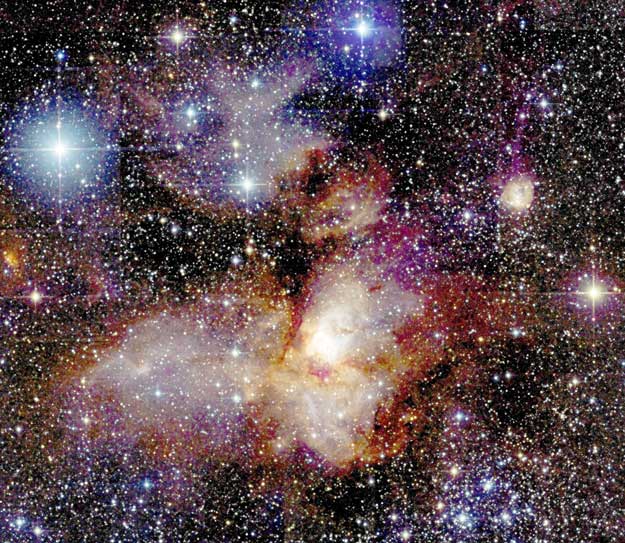Skip to comments.
Astronomy Picture of the Day 7-17-02
NASA ^
| 7-17-02
| Robert Nemiroff and Jerry Bonnell
Posted on 07/16/2002 9:30:02 PM PDT by petuniasevan
Astronomy Picture of the Day
Discover the cosmos! Each day a different image or photograph of our fascinating universe is featured, along with a brief explanation written by a professional astronomer.
2002 July 17

Star Forming Region RCW38 from 2MASS
Credit: R. Hurt, 2MASS Project, UMass, IPAC/Caltech, NSF, NASA
Explanation: The star cluster in RCW38 was hiding. Looking at the star forming region RCW38 will not normally reveal most of the stars in this cluster. The reason is that the open cluster is so young that it is still shrouded in thick dust that absorbs visible light. This dust typically accompanies the gas that condenses to form young stars. When viewed in infrared light, however, many stars in RCW38 are revealed, because dust is less effective at absorbing infrared light. The above representative-color image mosaic of RCW38 taken by the 2MASS sky survey in infrared light shows not only many bright blue stars from the star cluster but clouds of brightly emitting gas and dramatic lanes of dark dust. RCW38 spans about 10 light-years and is located about 5500 light years away towards the constellation of Vela.
TOPICS: Astronomy; Astronomy Picture of the Day; Science
KEYWORDS: 2mass; astronomy; cluster; dust; gas; hidden; image; infrared; micron; photography; sky; star; stars; survey; vela; young
Astronomy Fun Fact: This region is near the Vela supernova remnant.
Similar remnants in ages past may have been responsible for the formation of this dust cloud and its nascent stars.
Get on the APOD PING list! 
To: MozartLover; Joan912; NovemberCharlie; snowfox; Dawgsquat; viligantcitizen; theDentist; grlfrnd; ...
APOD PING!

To: petuniasevan
What is that, maybe 2000 stars in one frame on my low-res screen? We can see about 7000 individual stars in the whole sky [not just horizon to horizon but all the way around] in the best of conditions.
With the poor to moderate night skies we have these days, more than a few hundred visible stars would be a rarity for many people, perhaps the majority on earth.
To: petuniasevan
Really nice......thanks!

To: petuniasevan; Budge; Internet Golfer; Snow Bunny; 68-69TonkinGulfYatchClub; B4Ranch; Billie; ...
Darn I love your posts!! :o)
They always "brighten" my day!!
To: petuniasevan
It is great to see the fourth dimension,
Recorded in this way!
Ten light-years are spanned
All 5500 light-years away!
Time and space blend somehow,
As plain as it can be.
Please keep sending me these pings,
I'll be waiting impatiently!
6
posted on
07/17/2002 6:57:43 AM PDT
by
Graewoulf
To: petuniasevan
I wish, my dear Kepler, that we could have a good laugh together at the extraordinary stupidity of the mob. What do you think of the foremost philosophers of this University? In spite of my oft-repeated efforts and invitations, they have refused, with the obstinacy of a glutted adder, to look at the planets or Moon or my telescope. Galileo Galilei
7
posted on
07/17/2002 7:27:38 AM PDT
by
Sock
To: petuniasevan
This dust typically accompanies the gas that condenses to form young stars.
Ha ha ha ha ha ha ha ha.
8
posted on
07/17/2002 8:32:06 AM PDT
by
aruanan
To: Sock
Interesting quote. ;^)
To: petuniasevan
Thanks.
I always enjoy APOD!
To: petuniasevan
Amazing! Great picture. My whole family enjoys this site.
12
posted on
06/02/2010 2:52:58 PM PDT
by
bigheadfred
(If I've said it once, I've said it a million times...)
To: bigheadfred
13
posted on
08/15/2010 9:00:57 PM PDT
by
bigheadfred
(apoplectic purple)
Disclaimer:
Opinions posted on Free Republic are those of the individual
posters and do not necessarily represent the opinion of Free Republic or its
management. All materials posted herein are protected by copyright law and the
exemption for fair use of copyrighted works.
FreeRepublic.com is powered by software copyright 2000-2008 John Robinson

